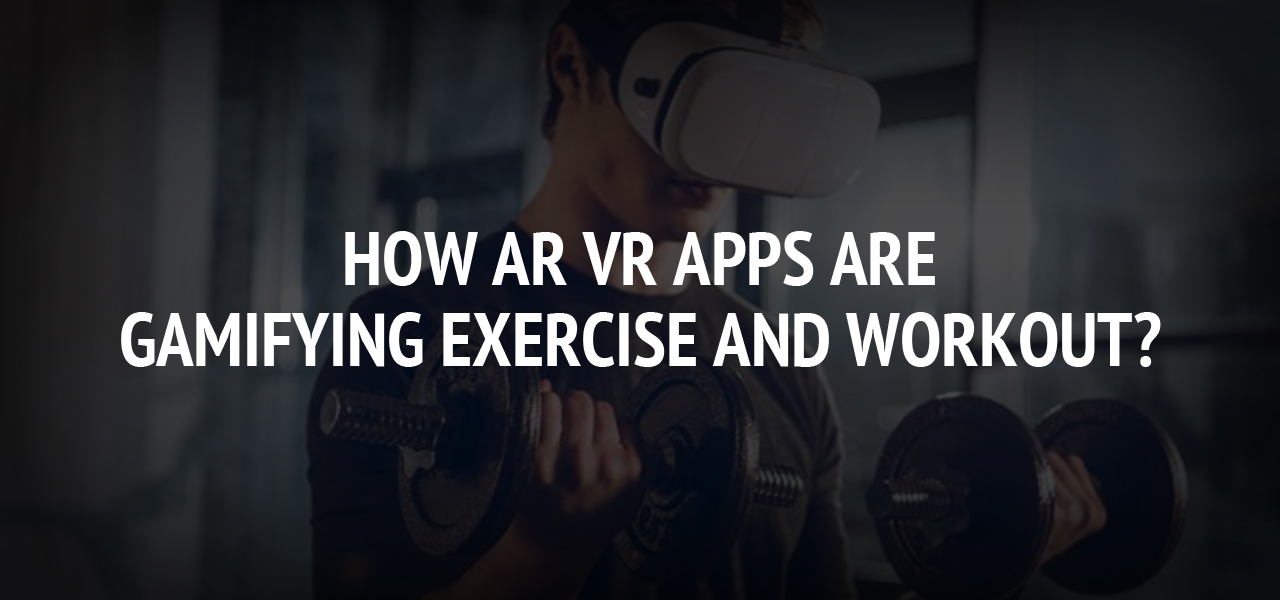How AR VR Apps Are Gamifying Exercise And Workout?

Technology is known for increasing comfort and convenience in our lives. But, both AR and VR technologies remain ready to transform the way people do exercises and workouts when it comes to health and fitness. Both these technologies make workouts more enjoyable for app users and assist them to achieve their fitness goals. In other words, augmented and virtual reality technologies enable gyms and fitness clubs to attract more customers by gamifying exercises.
Let’s go through the ways both these technologies can gamify exercises. But before digging deep into them, we will understand the capability of AR and VR technologies individually.
Augmented Reality can add digital content including image, voice, or video in the real world to make it more interesting. It is useful for enticing customers by providing them rich visual experience. Talking about the fitness industry, AR technology can make exercises more interesting and motivate users to achieve their goals. Fitness tracking app development companies can integrate AR-based features to make the app more user-friendly.
Virtual Reality (VR) technology, on the other hand, can offer an immersive experience. App users can get a rich visual experience effectively like real life just by wearing a simple VR headset. Fitness VR apps can easily make exercise and workout schedules more interesting through lifelike sounds and visuals. An American startup has created a unique VR fitness app to enable users to remain physically active. VR-powered apps can assist people to stay active and fit.
According to the Statista report, AR and VR market size is expected to increase from 30 billion USD in 2021 to 297 billion USD in 2024.
Let’s go through seven ways AR and VR technologies can give an engaging experience through gamification of the exercise and workout routines.
Top Ways AR and VR Technologies Bring Gamification in Exercise Routine
1. Innovative and Interesting Ways for Workouts
AR and VR app development companies can come up with different, innovative ideas to make the fitness app more interesting for users. For example, a virtual cycling competition can be arranged through an app to enable users to compete with one another and share their progress on social media accounts. Gasification directly addresses the competitive nature of humans and app users keep full concentration in maintaining exercises and workouts.
2. Make Health Goals Achievable
Some years before when the fitness tracking app development domain was in the nascent stage, fitness freaks found it very difficult to measure their progress and monitor exercises or workouts in real-time. Today, fitness apps are highly advanced and assist users to set little challenging goals and achieve them. VR-based fitness tracking apps can do this for users, and track the rate of activities to determine whether they are achievable or not.
3. Keep Users Motivated for Exercises
This is one of the biggest benefits of gamification in fitness apps. Constant motivation is essential for people to meet their fitness goals. The AR and VR workout apps can keep people motivated to stay fit through gamification. Users can make new records by beating their high scores every time, which keeps them motivated all the time for workout sessions. Everyone likes to play their favorite games and stay healthy, gamification addresses this objective effectively.
4. Suggest Necessary Exercises
In contrast to diet and nutrition app, fitness tracking apps tend to suggest exercises based on the user’s daily activities, BMR (Basic Metabolic Rate), age, and weight. The app can give an exercise routine for achieving maximum outcome thereby assisting the users to achieve their fitness goals. As compared to appointing a personal trainer, fitness tracking apps remain more powerful in suggesting necessary exercises as per the user’s body requirements.
5. High Suitability for Schedules
Most people tend to avoid waking up early to do exercises. Even health-conscious people just hate to visiting the gym in the morning or the evening. They like virtual workout apps because these apps enable them to make a workout schedule as per the user’s convenience. These days, many gyms also offer virtual reality games and dedicated apps as a part of their exercise program. High suitability and excellent flexibility for workouts are possible with the VR and AR-powered fitness tracking apps.
6. Track All Workouts and Exercises
A sedentary lifestyle and flaws in eating habits make us vulnerable to various diseases or disorders. VR and AR-based fitness apps can enable people to track all the activities, exercises, and overall health conditions. The type and amount of workout necessary for particular body requirements can be given through such apps. The app development company can integrate VR and AR-based features into diet & nutrition apps to motivate users to take a healthy diet.
7. Add Fun Factor in Exercises
Finally, both these technologies add a fun factor to the fitness app. Gamification makes everything more interesting and attracts many people. Fitness tracking apps with AR and VR-powered features can show an engaging and entertaining way to get health-related goals. Users can have fun while burning some calories thanks to gamification. Fitness clubs can visit the app development company that utilizes AR and VR technologies for bringing such an interesting workout app.
Concluding Lines
Be it fitness tracking app development or building a customized diet & nutrition app, advancing AR and VR technologies can provide an excellent experience to app users through gamification. Gyms and fitness clubs can come up with innovative apps that show entertaining ways to the app users for reaching fitness goals. Though both these technologies are still in a nascent stage, we can expect richer workout experience and better services in the near future.
About The Author
Related Blog
View All-
How Computer Security Can Affect Your Dota 2 Score: Protecting Your System for Optimal Performance
In the competitive realm of Dota 2, maintaining optimal system performance is crucial to achieving high scores. However, many players overlook the role that computer security plays in ensuring a smooth gaming experience. Security threats like malware, phishing ...
-
5 Best Free Gaming Video Editing Tools For Beginners
What about editing gaming videos and uploading them on different platforms to get some of the most wonderful comments from the viewers? Isn't it an interesting task? The task is interesting, but the process can be daunting if you fail to choose the right video ...







